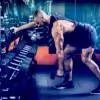What is the optimal way to perform repetitions if you want to maximize muscle growth?
Overview
What did they test? This narrative review looked at the current literature on the different variables of exercise technique and how to best manipulate them to maximize hypertrophy.
What did they find? Training technique may be more flexible than previously thought with the main variables that need to be manipulated being range of motion and repetition tempo.
What does it mean for you? Ensure that you’re getting a good stretch on the muscle that you’re targeting with a repetition duration of 2-8 seconds while maintaining some eccentric control.
What’s the Problem?
From the moment we lift our first dumbbell to our first attempts at learning more about muscle growth, one thing is highlighted as a non-negotiable variable when lifting weights, regardless of one’s goal. That variable is “technique”. From safety to muscle growth optimization, having “good technique” (or “form) is something you will hear from anyone that has ever stepped foot in a gym. The term "training technique" encompasses the different elements that make up an exercise, and it is common to hear that you should manipulate your body positioning in order to better recruit a specific muscle or that you must spend a specific amount of time during the concentric and/or eccentric phase of a repetition if you truly want to see results. Overall, training technique is very often highlighted as a variable that can make or break your results in the gym.

However, a challenge arises in defining what exactly constitutes "proper technique" and its components. The absence of a universally agreed-upon definition has led to a variety of perspectives. For instance, the NSCA Exercise Technique Manual 1 outlines a checklist of components, such as muscle groups involved, grip, stance, body position, and ROM. Yet, the definition of appropriate technique can heavily depend on an individual's specific training goals (eg: whether they aim for hypertrophy or power training).
Up until this review 2, there was no formal definition of training technique in the literature with our research group proposing the following definition:
“Resistance training exercise technique pertains to the controlled execution of bodily movements to ensure an exercise effectively targets specific muscle groups while minimizing the risk of injury. This involves the orchestration of body positioning and alignment, ROM, and repetition tempo.”
Despite the emphasis on the importance of appropriate exercise technique in resistance training literature and practice, there is a scarcity of research directly exploring its impact on the effectiveness of RT or injury prevention. Guidelines for prescribing exercise technique currently include exercise-specific recommendations for body positioning, alignment, and ROM, as well as tempo recommendations that vary based on individual training goals.
While researchers have highlighted the significance of learning "proper technique" in the early stages of resistance training, ambiguity remains as they do not explicitly define what this entails.
In light of these gaps in the existing literature, this hot-off-the-press narrative review aims to synthesize evidence on what constitutes an optimal approach to resistance training technique for maximizing hypertrophy. Additionally, the review seeks to provide recommendations for future research on the effects of resistance training technique on muscle hypertrophy, contributing valuable insights to both scientific understanding and practical application in the realm of muscle development.
Transparency disclaimer: The paper presented in this article is a narrative review written by myself and colleagues. Given the narrative nature of the review, this article will not follow the traditional subsection format that most REPS articles follow and it will narrate the current state of the literature as presented on the narrative review itself.










